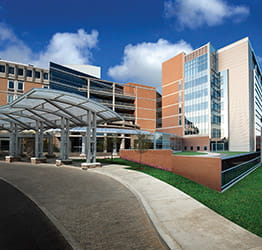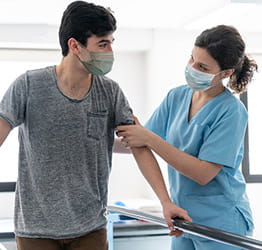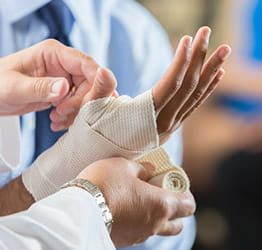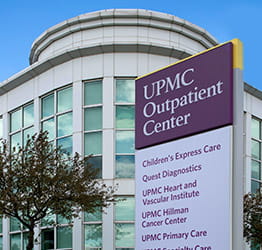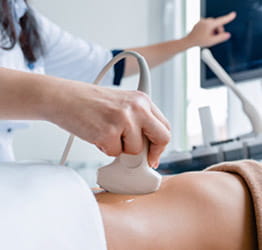Your lymphatic system — the system responsible for carrying white blood cells that fight infection — is a major route through which cancer cells can spread to other areas of your body. If breast cancer cells break through the affected duct or lobe and enter your surrounding breast tissue, they have the potential to travel to the lymph nodes under your arm and then spread to other parts of your body.
A sentinel lymph node (SLN) biopsy is a minimally invasive surgical procedure to remove the sentinel (main) lymph node to check for cancer. UPMC breast surgeons perform expert SLN biopsy procedures to determine the stage of your breast cancer and recommend a personalized treatment plan.
What Is Sentinel Lymph Node (SLN) Biopsy?
Your lymphatic system — the system responsible for carrying white blood cells that fight infection — is a major route through which cancer cells can spread to other areas of your body. If breast cancer cells break through the affected duct or lobe and enter your surrounding breast tissue, they can sometimes travel to the lymph nodes under your arm and spread to other parts of your body.
A sentinel lymph node (SLN) biopsy is a minimally invasive surgical procedure to remove the sentinel (main) lymph node to check for cancer.
Types of SLN biopsy
There are two types of SLN biopsy, including:
- Radioactive tracer SLN biopsy — Uses a small amount of radioactive material called a radiotracer, which is injected near your tumor and travels through your lymph nodes. The radiotracer highlights your sentinel lymph node, allowing your doctor to see it when using a special device.
- Blue dye SLN biopsy — Uses blue dye injected near your tumor, which stains your sentinel lymph node blue.
Why Would I Need A SLN Biopsy?
If you’ve been diagnosed with invasive breast cancer, you will need an SLN biopsy to determine whether your cancer has spread to your lymph nodes.
Who’s a candidate for SLN biopsy?
You may be a candidate for SLN biopsy if your doctor wants to test your sentinel lymph node to see if your cancer has spread.
What Are the Risks and Complications of SLN Biopsy?
Risks of sentinel lymph node biopsy include:
- Allergic reactions to the radiotracer or dye.
- Bleeding, infection, pain, or bruising at the site of your biopsy.
- Lymphedema, which causes swelling in your arm from excess lymph fluid.
What Should I Expect From SLN Biopsy?
Before: How to prepare for SLN biopsy
To prepare for the procedure, you should:
- Fast for a certain period of time prior to the procedure. Your doctor will tell you if you need to fast and, if so, how long (usually overnight).
- Have any tests that your doctor recommends. For example, your doctor may request a blood test before the procedure to determine how long it takes your blood to clot.
- Tell your doctor if you are sensitive or allergic to any medications, iodine, latex, tape, or anesthetic agents (local and general).
- Tell your doctor about all medications (prescription and over-the-counter) and herbal or other supplements you are taking.
- Tell your doctor if you have any other health conditions. Your care team may need to take certain precautions during your procedure for your safety.
- Tell your doctor if you have a history of bleeding disorders or if you are taking any blood-thinning medications, aspirin, or other medications that affect blood clotting. You may need to stop some of the medications prior to the procedure.
- Tell your doctor if you are breastfeeding, pregnant, or think you might be pregnant.
How long does SLN biopsy take?
Your SLN biopsy procedure will take 30 to 60 minutes.
During your SLN biopsy
During your SLN biopsy, your surgeon will:
- Use local anesthesia to numb the biopsy area.
- Inject the dye or radiotracer near your tumor to identify the SLN, the main lymph node to which your cancer is likely to have spread first.
- Identify the SLN using dye or a special device that detects the radiotracer.
- Give you general anesthesia to put you to sleep.
- Make a small incision and remove the SLN for biopsy.
- Send your SLN biopsy sample to a pathologist who examines it in the lab to determine if cancer is present.
Your surgeon may also remove your tumor during the same operation.
Recovery after SLN biopsy
After your procedure is complete, you will be monitored in the recovery area before being discharged or transferred to a hospital room. Depending on whether you had an SLN biopsy only or an additional surgical procedure to remove your tumor, you may be discharged or need to spend one or more nights in the hospital. You will need someone to drive you home from the hospital after your discharge.
Before you go home, your doctor will tell you:
- How to care for your incision and watch for signs of infection or complications.
- What medications you need to take.
- When to call your doctor or 911 if you have certain symptoms.
- When to schedule your follow-up appointments, if one has not been scheduled already.
- When you can return to your normal activities, such as driving and bathing.
How painful is an SLN biopsy?
Your doctor will numb your breast with a local anesthetic to inject the dye or radiotracer and put you to sleep to remove your lymph node. You shouldn’t feel any pain during your procedure. After your procedure, you may have some discomfort or bruising.
What do the results of an SLN biopsy mean?
If your pathology results show that no cancer has been found, you will not need additional surgery to remove your lymph nodes.
If cancer is found, you may need a procedure called a full axillary lymph node dissection to remove one or more or all the lymph nodes in your underarm. However, in some cases, no additional surgery is necessary if cancer is detected.
Your doctor will contact you to discuss your results and outline the next steps in your treatment plan.
When to call your doctor about complications
You should let your surgeon know if you have:
- A fever of over 100.0°F.
- Difficulty breathing.
- Pain, redness, bleeding, drainage, or increased swelling at your treatment site.
- Severe pain that does not respond to medication.
Why Choose UPMC for SLN Biopsy?
When you choose UPMC for SLN biopsy, you will receive:
- Access to advanced imaging technology — Our experts use the latest imaging technology to quickly and accurately diagnose and treat a full range of health conditions.
- Convenient imaging services — Imaging appointments are available at multiple locations with hours that fit your schedule.
- Multidisciplinary care — We partner with breast surgeons, medical oncologists, radiation oncologists, breast reconstructive surgeons, and other medical experts to treat breast cancer and other breast conditions.
By UPMC Editorial Staff. Last reviewed on 2025-08-28.





